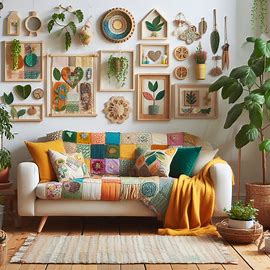
Introduction
In a world increasingly focused on sustainability, upcycling has emerged as a creative and responsible way to decorate your home. Instead of buying new, you can transform what you already have or repurpose secondhand items into functional and beautiful décor. These upcycling tips for eco-friendly home décor will guide you through sustainable decorating while encouraging creativity and conscious living.
1. The Basics of Upcycling for Beginners
Upcycling involves giving old or discarded items a new purpose or aesthetic. Unlike recycling, which breaks down materials into raw form, upcycling maintains the original structure and elevates it.
1.1 Why Choose Upcycling?
There are several compelling reasons to embrace upcycling in your home decor:
- Reduces landfill waste
- Conserves energy and resources
- Saves money on décor and furnishings
- Adds unique, personalized charm to your space
Upcycling encourages a mindset shift—from disposable to intentional living.
1.2 Identifying Upcyclable Items
Look around your home or local thrift shops for potential treasures.
- Wooden crates and pallets
- Glass jars and bottles
- Old furniture and mirrors
- Discarded textiles like curtains, denim, or upholstery
Ask yourself: Can this be painted, reassembled, or repurposed?
2. Room-by-Room Upcycling Ideas
Each room in your home offers opportunities for stylish, sustainable upcycled decor. Here are room-specific ideas to inspire your eco-friendly transformations.
2.1 Living Room
- Coffee Table from Pallets: Sand and stain pallets for a rustic or modern look
- Wall Art from Scrap Wood: Use wood offcuts and old frames to create statement pieces
- Tire Ottoman: Wrap an old tire in rope for a sturdy and stylish footrest
2.2 Kitchen
- Jar Storage: Turn mason jars into spice holders or utensil caddies
- Drawer Shelves: Mount old drawers on walls for floating shelves
- Bottle Lighting: Convert wine bottles into pendant lights
2.3 Bedroom
- Headboard from Old Doors: Sand and paint vintage doors for a boho headboard
- Denim Pillow Covers: Use old jeans for durable, stylish cushion covers
- Ladder Clothing Rack: Repurpose an old wooden ladder for hanging clothes or accessories
2.4 Bathroom
- Crate Shelving: Stack and screw wooden crates together for rustic storage
- Vintage Mirrors: Reframe or repaint old mirrors to suit your aesthetic
- Towel Hooks from Salvaged Materials: Use knobs or handles as hooks
2.5 Outdoor Spaces
- Chair Planters: Remove seats from old chairs and add pots
- Bottle Garden Edging: Use colorful bottles to edge garden beds
- Wooden Spool Tables: Repurpose cable spools as garden tables
3. Tools and Techniques for Successful Upcycling
Getting the right tools and mastering basic techniques can take your projects from good to great.
3.1 Essential Tools for Beginners
- Sandpaper and electric sander
- Paintbrushes and eco-friendly paints
- Hot glue gun
- Power drill and screwdriver
- Fabric scissors and sewing machine (optional)
Tip: Always use non-toxic, low-VOC paints and adhesives to keep your home eco-safe.
3.2 Common Upcycling Techniques
| Technique | Description |
|---|---|
| Distressing | Giving furniture a worn look using sanding |
| Decoupage | Gluing paper cutouts to surfaces with sealant |
| Stenciling | Adding designs with paint and templates |
| Reupholstering | Changing fabric on cushions or furniture |
| Mosaic Tiling | Applying broken tile or glass for decoration |
Start with easy projects to build confidence before taking on more complex designs.
4. Upcycling with Kids and Family
Upcycling can also be a fun family activity that instills values of sustainability, creativity, and teamwork.
4.1 Safe and Fun Projects for Children
- Tin Can Pencil Holders: Let kids paint and decorate empty cans
- Bottle Cap Art: Use old caps to form colorful mosaics
- Cardboard Castles: Turn packaging into elaborate play forts
These projects encourage problem-solving, imagination, and hands-on learning.
4.2 Making Upcycling a Lifestyle
- Have monthly family upcycling sessions
- Challenge each member to find and upcycle one item per month
- Display creations proudly around the home
It’s about more than décor—it’s about fostering eco-awareness in everyday life.
5. Sourcing Sustainable Materials and Inspiration
Knowing where to find materials and how to stay inspired ensures your upcycling efforts remain fresh and enjoyable.
5.1 Best Places to Find Upcycling Materials
- Thrift shops and garage sales
- Online platforms like Freecycle or Facebook Marketplace
- Community swap meets or donation centers
- Your own attic, basement, or garage
Look for sturdy, repairable items with good “bones.”
5.2 Staying Inspired and Connected
- Follow eco-friendly influencers or blogs
- Subscribe to DIY YouTube channels
- Join local upcycling or maker communities
Example Table: Inspirational Upcycling Accounts to Follow
| Platform | Creator/Group | Focus Area |
| @upcyclethat | General home décor ideas | |
| DIY Upcycling Projects Board | Step-by-step visuals | |
| YouTube | The Sorry Girls | Trendy, beginner-friendly |
| Upcycle Nation Group | Community sharing & ideas |
Conclusion: Turn Trash into Treasure
Upcycling is more than a trend; it’s a meaningful way to decorate with conscience and creativity. By applying these upcycling tips for eco-friendly home décor, you’re not just making your home more beautiful—you’re contributing to a more sustainable world.
Which item in your home are you excited to upcycle first? Share your ideas or photos in the comments to inspire others and keep the creativity flowing!